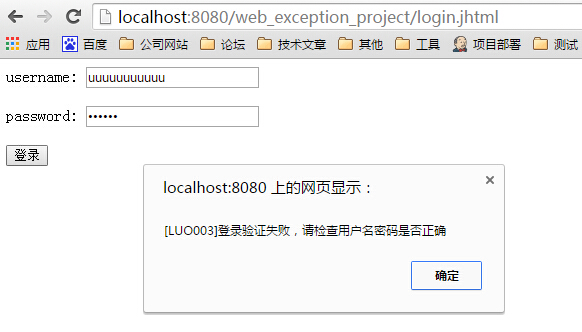一、Shiro框架簡單介紹
?
前些天發現了一個巨牛的人工智能學習網站,通俗易懂,風趣幽默,忍不住分享一下給大家。點擊跳轉到教程。
?
Apache Shiro是Java的一個安全框架,旨在簡化身份驗證和授權。Shiro在JavaSE和JavaEE項目中都可以使用。它主要用來處理身份認證,授權,企業會話管理和加密等。Shiro的具體功能點如下:
(1)身份認證/登錄,驗證用戶是不是擁有相應的身份;?
(2)授權,即權限驗證,驗證某個已認證的用戶是否擁有某個權限;即判斷用戶是否能做事情,常見的如:驗證某個用戶是否擁有某個角色。或者細粒度的驗證某個用戶對某個資源是否具有某個權限;?
(3)會話管理,即用戶登錄后就是一次會話,在沒有退出之前,它的所有信息都在會話中;會話可以是普通JavaSE環境的,也可以是如Web環境的;?
(4)加密,保護數據的安全性,如密碼加密存儲到數據庫,而不是明文存儲;?
(5)Web支持,可以非常容易的集成到Web環境;?
Caching:緩存,比如用戶登錄后,其用戶信息、擁有的角色/權限不必每次去查,這樣可以提高效率;?
(6)shiro支持多線程應用的并發驗證,即如在一個線程中開啟另一個線程,能把權限自動傳播過去;?
(7)提供測試支持;?
(8)允許一個用戶假裝為另一個用戶(如果他們允許)的身份進行訪問;?
(9)記住我,這個是非常常見的功能,即一次登錄后,下次再來的話不用登錄了。
文字描述可能并不能讓猿友們完全理解具體功能的意思。下面我們以登錄驗證為例,向猿友們介紹Shiro的使用。至于其他功能點,猿友們用到的時候再去深究其用法也不遲。
二、Shiro實例詳細說明
本實例環境:eclipse + maven?
本實例采用的主要技術:spring + springmvc + shiro
2.1、依賴的包
假設已經配置好了spring和springmvc的情況下,還需要引入shiro以及shiro集成到spring的包,maven依賴如下:
<!-- Spring 整合Shiro需要的依賴 -->
<dependency> <groupId>org.apache.shiro</groupId> <artifactId>shiro-core</artifactId> <version>1.2.1</version>
</dependency>
<dependency> <groupId>org.apache.shiro</groupId> <artifactId>shiro-web</artifactId> <version>1.2.1</version>
</dependency>
<dependency> <groupId>org.apache.shiro</groupId> <artifactId>shiro-ehcache</artifactId> <version>1.2.1</version>
</dependency>
<dependency> <groupId>org.apache.shiro</groupId> <artifactId>shiro-spring</artifactId> <version>1.2.1</version>
</dependency> - ?
2.2、定義shiro攔截器
對url進行攔截,如果沒有驗證成功的需要驗證,然后額外給用戶賦予角色和權限。
自定義的攔截器需要繼承AuthorizingRealm并實現登錄驗證和賦予角色權限的兩個方法,具體代碼如下:
package com.luo.shiro.realm;import java.util.HashSet;
import java.util.Set;
import org.apache.shiro.authc.AuthenticationException;
import org.apache.shiro.authc.AuthenticationInfo;
import org.apache.shiro.authc.AuthenticationToken;
import org.apache.shiro.authc.SimpleAuthenticationInfo;
import org.apache.shiro.authc.UsernamePasswordToken;
import org.apache.shiro.authz.AuthorizationInfo;
import org.apache.shiro.authz.SimpleAuthorizationInfo;
import org.apache.shiro.realm.AuthorizingRealm;
import org.apache.shiro.subject.PrincipalCollection;
import com.luo.util.DecriptUtil;public class MyShiroRealm extends AuthorizingRealm {//這里因為沒有調用后臺,直接默認只有一個用戶("luoguohui","123456")private static final String USER_NAME = "luoguohui"; private static final String PASSWORD = "123456"; /* * 授權*/@Overrideprotected AuthorizationInfo doGetAuthorizationInfo(PrincipalCollection principals) { Set<String> roleNames = new HashSet<String>(); Set<String> permissions = new HashSet<String>(); roleNames.add("administrator");//添加角色permissions.add("newPage.jhtml"); //添加權限SimpleAuthorizationInfo info = new SimpleAuthorizationInfo(roleNames); info.setStringPermissions(permissions); return info; }/* * 登錄驗證*/@Overrideprotected AuthenticationInfo doGetAuthenticationInfo(AuthenticationToken authcToken) throws AuthenticationException {UsernamePasswordToken token = (UsernamePasswordToken) authcToken;if(token.getUsername().equals(USER_NAME)){return new SimpleAuthenticationInfo(USER_NAME, DecriptUtil.MD5(PASSWORD), getName()); }else{throw new AuthenticationException(); }}}
- ?
2.3、shiro配置文件
spring-shiro.xml文件內容如下:
<?xml version="1.0" encoding="UTF-8"?>
<beans xmlns="http://www.springframework.org/schema/beans" xmlns:xsi="http://www.w3.org/2001/XMLSchema-instance" xsi:schemaLocation="http://www.springframework.org/schema/beans http://www.springframework.org/schema/beans/spring-beans-3.0.xsd" default-lazy-init="true"> <description>Shiro Configuration</description> <!-- Shiro's main business-tier object for web-enabled applications --> <bean id="securityManager" class="org.apache.shiro.web.mgt.DefaultWebSecurityManager"> <property name="realm" ref="myShiroRealm" /> <property name="cacheManager" ref="cacheManager" /> </bean> <!-- 項目自定義的Realm --> <bean id="myShiroRealm" class="com.luo.shiro.realm.MyShiroRealm"> <property name="cacheManager" ref="cacheManager" /> </bean> <!-- Shiro Filter --> <bean id="shiroFilter" class="org.apache.shiro.spring.web.ShiroFilterFactoryBean"> <property name="securityManager" ref="securityManager" /> <property name="loginUrl" value="/login.jhtml" /> <property name="successUrl" value="/loginsuccess.jhtml" /> <property name="unauthorizedUrl" value="/error.jhtml" /> <property name="filterChainDefinitions"> <value> /index.jhtml = authc /login.jhtml = anon/checkLogin.json = anon /loginsuccess.jhtml = anon /logout.json = anon /** = authc </value> </property> </bean> <!-- 用戶授權信息Cache --> <bean id="cacheManager" class="org.apache.shiro.cache.MemoryConstrainedCacheManager" /> <!-- 保證實現了Shiro內部lifecycle函數的bean執行 --> <bean id="lifecycleBeanPostProcessor" class="org.apache.shiro.spring.LifecycleBeanPostProcessor" /> <!-- AOP式方法級權限檢查 --> <bean class="org.springframework.aop.framework.autoproxy.DefaultAdvisorAutoProxyCreator" depends-on="lifecycleBeanPostProcessor"> <property name="proxyTargetClass" value="true" /> </bean> <bean class="org.apache.shiro.spring.security.interceptor.AuthorizationAttributeSourceAdvisor"> <property name="securityManager" ref="securityManager" /> </bean> </beans> - ?
這里有必要說清楚”shiroFilter” 這個bean里面的各個屬性property的含義:
(1)securityManager:這個屬性是必須的,沒什么好說的,就這樣配置就好。?
(2)loginUrl:沒有登錄的用戶請求需要登錄的頁面時自動跳轉到登錄頁面,可配置也可不配置。?
(3)successUrl:登錄成功默認跳轉頁面,不配置則跳轉至”/”,一般可以不配置,直接通過代碼進行處理。?
(4)unauthorizedUrl:沒有權限默認跳轉的頁面。?
(5)filterChainDefinitions,對于過濾器就有必要詳細說明一下:
1)Shiro驗證URL時,URL匹配成功便不再繼續匹配查找(所以要注意配置文件中的URL順序,尤其在使用通配符時),故filterChainDefinitions的配置順序為自上而下,以最上面的為準
2)當運行一個Web應用程序時,Shiro將會創建一些有用的默認Filter實例,并自動地在[main]項中將它們置為可用自動地可用的默認的Filter實例是被DefaultFilter枚舉類定義的,枚舉的名稱字段就是可供配置的名稱
3)通常可將這些過濾器分為兩組:
anon,authc,authcBasic,user是第一組認證過濾器
perms,port,rest,roles,ssl是第二組授權過濾器
注意user和authc不同:當應用開啟了rememberMe時,用戶下次訪問時可以是一個user,但絕不會是authc,因為authc是需要重新認證的?
user表示用戶不一定已通過認證,只要曾被Shiro記住過登錄狀態的用戶就可以正常發起請求,比如rememberMe
說白了,以前的一個用戶登錄時開啟了rememberMe,然后他關閉瀏覽器,下次再訪問時他就是一個user,而不會authc
4)舉幾個例子?
/admin=authc,roles[admin] 表示用戶必需已通過認證,并擁有admin角色才可以正常發起’/admin’請求?
/edit=authc,perms[admin:edit] 表示用戶必需已通過認證,并擁有admin:edit權限才可以正常發起’/edit’請求?
/home=user 表示用戶不一定需要已經通過認證,只需要曾經被Shiro記住過登錄狀態就可以正常發起’/home’請求
5)各默認過濾器常用如下(注意URL Pattern里用到的是兩顆星,這樣才能實現任意層次的全匹配)?
/admins/**=anon 無參,表示可匿名使用,可以理解為匿名用戶或游客?
/admins/user/**=authc 無參,表示需認證才能使用?
/admins/user/**=authcBasic 無參,表示httpBasic認證?
/admins/user/**=user 無參,表示必須存在用戶,當登入操作時不做檢查?
/admins/user/**=ssl 無參,表示安全的URL請求,協議為https?
/admins/user/*=perms[user:add:]?
參數可寫多個,多參時必須加上引號,且參數之間用逗號分割,如/admins/user/*=perms[“user:add:,user:modify:*”]?
當有多個參數時必須每個參數都通過才算通過,相當于isPermitedAll()方法?
/admins/user/**=port[8081]?
當請求的URL端口不是8081時,跳轉到schemal://serverName:8081?queryString?
其中schmal是協議http或https等,serverName是你訪問的Host,8081是Port端口,queryString是你訪問的URL里的?后面的參數?
/admins/user/**=rest[user]?
根據請求的方法,相當于/admins/user/**=perms[user:method],其中method為post,get,delete等?
/admins/user/**=roles[admin]?
參數可寫多個,多個時必須加上引號,且參數之間用逗號分割,如/admins/user/**=roles[“admin,guest”]?
當有多個參數時必須每個參數都通過才算通過,相當于hasAllRoles()方法
上文參考了http://www.cppblog.com/guojingjia2006/archive/2014/05/14/206956.html,更多詳細說明請訪問該鏈接。
2.4、web.xml配置引入對應的配置文件和過濾器
<!-- 讀取spring和shiro配置文件 -->
<context-param><param-name>contextConfigLocation</param-name><param-value>classpath:application.xml,classpath:shiro/spring-shiro.xml</param-value>
</context-param><!-- shiro過濾器 -->
<filter> <filter-name>shiroFilter</filter-name> <filter-class>org.springframework.web.filter.DelegatingFilterProxy</filter-class> <init-param> <param-name>targetFilterLifecycle</param-name> <param-value>true</param-value> </init-param>
</filter>
<filter-mapping> <filter-name>shiroFilter</filter-name> <url-pattern>*.jhtml</url-pattern> <url-pattern>*.json</url-pattern>
</filter-mapping> - ?
2.5、controller代碼
package com.luo.controller;import java.util.HashMap;
import java.util.Map;import javax.servlet.http.HttpServletRequest;import org.apache.shiro.SecurityUtils;
import org.apache.shiro.authc.UsernamePasswordToken;
import org.apache.shiro.subject.Subject;
import org.springframework.stereotype.Controller;
import org.springframework.web.bind.annotation.RequestMapping;
import org.springframework.web.bind.annotation.RequestMethod;
import org.springframework.web.bind.annotation.ResponseBody;
import org.springframework.web.servlet.ModelAndView;import com.alibaba.druid.support.json.JSONUtils;
import com.luo.errorcode.LuoErrorCode;
import com.luo.exception.BusinessException;
import com.luo.util.DecriptUtil;@Controller
public class UserController {@RequestMapping("/index.jhtml")public ModelAndView getIndex(HttpServletRequest request) throws Exception {ModelAndView mav = new ModelAndView("index");return mav;}@RequestMapping("/exceptionForPageJumps.jhtml")public ModelAndView exceptionForPageJumps(HttpServletRequest request) throws Exception {throw new BusinessException(LuoErrorCode.NULL_OBJ);}@RequestMapping(value="/businessException.json", method=RequestMethod.POST)@ResponseBody public String businessException(HttpServletRequest request) {throw new BusinessException(LuoErrorCode.NULL_OBJ);}@RequestMapping(value="/otherException.json", method=RequestMethod.POST)@ResponseBody public String otherException(HttpServletRequest request) throws Exception {throw new Exception();}//跳轉到登錄頁面@RequestMapping("/login.jhtml")public ModelAndView login() throws Exception {ModelAndView mav = new ModelAndView("login");return mav;}//跳轉到登錄成功頁面@RequestMapping("/loginsuccess.jhtml")public ModelAndView loginsuccess() throws Exception {ModelAndView mav = new ModelAndView("loginsuccess");return mav;}@RequestMapping("/newPage.jhtml")public ModelAndView newPage() throws Exception {ModelAndView mav = new ModelAndView("newPage");return mav;}@RequestMapping("/newPageNotAdd.jhtml")public ModelAndView newPageNotAdd() throws Exception {ModelAndView mav = new ModelAndView("newPageNotAdd");return mav;}/** * 驗證用戶名和密碼 * @param String username,String password* @return */ @RequestMapping(value="/checkLogin.json",method=RequestMethod.POST) @ResponseBody public String checkLogin(String username,String password) { Map<String, Object> result = new HashMap<String, Object>();try{UsernamePasswordToken token = new UsernamePasswordToken(username, DecriptUtil.MD5(password)); Subject currentUser = SecurityUtils.getSubject(); if (!currentUser.isAuthenticated()){//使用shiro來驗證 token.setRememberMe(true); currentUser.login(token);//驗證角色和權限 } }catch(Exception ex){throw new BusinessException(LuoErrorCode.LOGIN_VERIFY_FAILURE);}result.put("success", true);return JSONUtils.toJSONString(result); } /** * 退出登錄*/ @RequestMapping(value="/logout.json",method=RequestMethod.POST) @ResponseBody public String logout() { Map<String, Object> result = new HashMap<String, Object>();result.put("success", true);Subject currentUser = SecurityUtils.getSubject(); currentUser.logout(); return JSONUtils.toJSONString(result);}
}
- ?
上面代碼,我們只需要更多地關注登錄驗證和退出登錄的代碼。?
其中DecriptUtil.MD5(password),對密碼進行md5加密解密是我自己寫的工具類DecriptUtil,對應MyShiroRealm里面的登錄驗證里面也有對應對應的方法。?
另外,BusinessException是我自己封裝的異常類。?
最后會提供整個工程源碼供猿友下載,里面包含了所有的代碼。
2.6、login.jsp代碼
<%@ page language="java" contentType="text/html; charset=UTF-8" pageEncoding="UTF-8"%>
<html>
<head>
<script src="<%=request.getContextPath()%>/static/bui/js/jquery-1.8.1.min.js"></script>
</head>
<body>
username: <input type="text" id="username"><br><br>
password: <input type="password" id="password"><br><br>
<button id="loginbtn">登錄</button>
</body>
<script type="text/javascript">
$('#loginbtn').click(function() {var param = {username : $("#username").val(),password : $("#password").val()};$.ajax({ type: "post", url: "<%=request.getContextPath()%>" + "/checkLogin.json", data: param, dataType: "json", success: function(data) { if(data.success == false){alert(data.errorMsg);}else{//登錄成功window.location.href = "<%=request.getContextPath()%>" + "/loginsuccess.jhtml";}},error: function(data) { alert("調用失敗...."); }});
});
</script>
</html>- ?
2.7、效果演示
(1)如果未登錄前,輸入http://localhost:8080/web_exception_project/index.jhtml會自動跳轉到http://localhost:8080/web_exception_project/login.jhtml。
(2)如果登錄失敗和登錄成功:
(3)如果登錄成功,訪問http://localhost:8080/web_exception_project/index.jhtml就可以到其對應的頁面了。
2.8、源碼下載
http://download.csdn.net/detail/u013142781/9426670
2.9、我遇到的坑
在本實例的調試里面遇到一個問題,雖然跟shiro沒有關系,但是也跟猿友們分享一下。?
就是ajax請求設置了“contentType : “application/json””,導致controller獲取不到username和password這兩個參數。?
后面去掉contentType : “application/json”,采用默認的就可以了。
具體原因可以瀏覽博文:http://blog.csdn.net/mhmyqn/article/details/25561535
?
轉自:https://blog.csdn.net/u013142781/article/details/50629708



)





)
)



)

![Luogu P3975 [TJOI2015]弦論](http://pic.xiahunao.cn/Luogu P3975 [TJOI2015]弦論)

)



